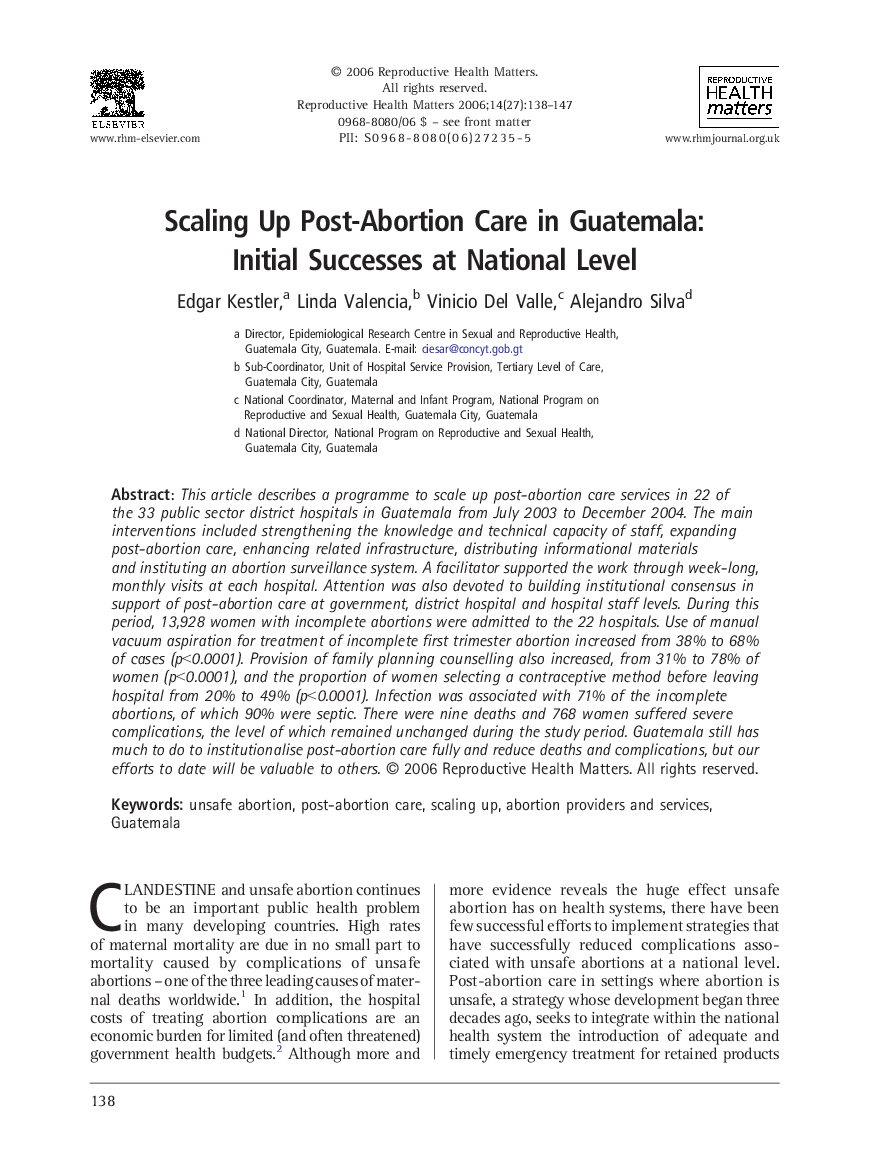| کد مقاله | کد نشریه | سال انتشار | مقاله انگلیسی | نسخه تمام متن |
|---|---|---|---|---|
| 1090521 | 952069 | 2006 | 10 صفحه PDF | دانلود رایگان |

This article describes a programme to scale up post-abortion care services in 22 of the 33 public sector district hospitals in Guatemala from July 2003 to December 2004. The main interventions included strengthening the knowledge and technical capacity of staff, expanding post-abortion care, enhancing related infrastructure, distributing informational materials andinstituting an abortion surveillance system. A facilitator supported the work through week-long, monthly visits at each hospital. Attention was also devoted to building institutional consensus in support of post-abortion care at government, district hospital and hospital staff levels. Duringthis period, 13,928 women with incomplete abortions were admitted to the 22 hospitals. Use of manual vacuum aspiration for treatment of incomplete first trimester abortion increased from 38% to 68% of cases (p<0.0001). Provision of family planning counselling also increased, from 31% to 78% of women (p<0.0001), and the proportion of women selecting a contraceptivemethod before leaving hospital from 20% to 49% (p<0.0001). Infection was associated with 71% of the incomplete abortions, of which 90% were septic. There were nine deaths and 768 women suffered severe complications, the level of which remained unchanged during the study period. Guatemala still has much to do to institutionalise post-abortion care fully and reduce deaths and complications, but our efforts to date will be valuable to others.
RésuméL'article décrit un programme d'élargissement des services de soins post-avortement dans 22 des 33 hôpitaux publics de district au Guatemala de juillet 2003 à décembre 2004. Les principales interventions visaient à renforcer les connaissances et les compétences techniques du personnel, agrandir les installations de soins post-avortement, améliorer les infrastructures de base liées, distribuer du matériel informatif et instaurer un système de surveillance des avortements. Un facilitateur a soutenu le travail pendant des visites mensuelles d'une semaine dans chaque hôpital. Une attention a aussi été accordée à l'établissement d'un consensus institutionnel à l'appui des soins post-avortement aux niveaux de l'État, des hôpitaux de district et du personnel hospitalier. Pendant cette période, 13 928 femmes présentant un avortement incomplet ont été admises dans les 22 hôpitaux. Le recours à l'aspiration manuelle pour traiter les avortements incomplets du premier trimestre est passé de 38% à 68% des cas (p<0,0001). Les consultations de planification familiale ont également augmenté, de 31% à 78% des femmes (p<0,0001), et la proportion de femmes choisissant une méthode contraceptive avant de quitter l'hôpital est passée de 20% à 49% (p<0,0001). Une infection était associée avec 71% des avortements incomplets, dont 90% étaient septiques. Neuf décès ont été enregistrés et 768 femmes ont présenté de graves complications, un niveau inchangé pendant la période de l'étude. Il reste encore beaucoup à faire au Guatemala pour institutionnaliser les soins post-avortement et réduire la mortalité et les complications, mais nos activités pourront servir à d'autres.
ResumenEn este artículo se describe un programa para ampliar los servicios de atención postaborto (APA) en 22 de los 33 hospitales distritales del sector público en Guatemala, desde julio de 2003 hasta diciembre de 2004. Las principales intervenciones fueron fortalecer los conocimientos y la capacidad técnica del personal; ampliar los servicios de APA; mejorar la infraestructura relacionada con la APA; distribuir material informativo e instituir un sistema de vigilancia de abortos. Un facilitador apoyó el trabajo mediante visitas mensuales de una semana de duración a cada hospital. Además, se prestó atención a desarrollar consenso institucional para apoyar la APA a nivel del gobierno, de los hospitales distritales y del personal hospitalario. Durante este período, 13,928 mujeres con aborto incompleto ingresaron en los 22 hospitales. El uso de la aspiración manual endouterina para el tratamiento del aborto incompleto en el primer trimestre aumentó del 38% al 68% de los casos (p<0.001). También aumentó la provisión de consejería sobre la planificación familiar, del 31% al 78% de las mujeres (p<0.001); y la proporción de mujeres que seleccionaron un método anticonceptivo, del 20% al 49% (p<0.001). El 71% de los abortos incompletos presentaron infección; de estos, el 90% eran sépticos. Hubo nueve muertes y 768 mujeres presentaron complicaciones graves, cuyo nivel permaneció igual a lo largo del estudio. En Guatemala aún falta mucho por hacer para institucionalizar completamente la atención postaborto y disminuir las muertes y complicaciones, pero nuestros logros hasta la fecha serán de utilidad para otros.
Journal: Reproductive Health Matters - Volume 14, Issue 27, May 2006, Pages 138–147